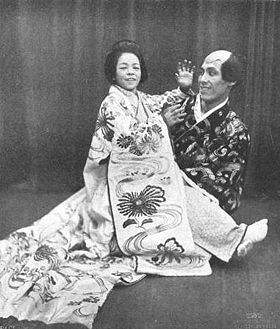Ōta Hisa
Ōta Hisa ( Japanese 大田 ひ さ ; * May 7, 1868 in Nakashima-gun , Owari Province (today: Aichi Prefecture ); † April 2, 1945 in Gifu , Gifu Prefecture ), also known as Hanako ( 花子 , dt. " Flower child, flower girl ”), Ōta Hanako ( 太 田 花子 ), Madame Hanako or Mme. Hanako , was a Japanese actress and dancer.
Life
Ōta Hisa toured extensively in Europe and North America from 1902 to 1921. The performances of the petite Hanako , estimated to be less than 155 cm and 35 kg , as they were only known, met with a positive to enthusiastic response. Their performances in 1908 Ronacher of Vienna were "nightly justly admired" , reported formerly the magazine Sport & Salon . As early as 1907, the New York Times devoted a full-page article to her. In 1910 she made her first trip to Russia. The playwright Nikolai Evreinov praised her "true theatrical art", which managed without clever manuscripts, expensive costumes and elaborate stage design.
Long-lasting fame came to her as the model of two masks by Auguste Rodin , whom she first met in 1906 in Marseilles. Between 1908, perhaps as early as 1906, and 1911 he made a series of 53 Hanako masks - more than any of his other models. Most of these masks are in the Musée Rodin in Paris. Two of the masks, however, the head of death and a meditating woman , were bequeathed by Rodin to Hanako and, after a checkered history, finally ended up in the Niigata Art Museum . The Japanese author Mori Ōgai wrote the short story Hanako as early as 1910 , based on Ōta Hisa and Rodin's fascination for her. In 1995 the Japanese documentary filmmaker Hisaya Iwasa filmed the love story between Rodin and Ota under the title Petite Hanako - The Actress Who Captured Rodin's Heart , with the dancer Anzu Furukawa in the lead role.
Ōta Hisa was the daughter of an impoverished farming family and one of eight siblings. In 1875 she was given up for adoption by a fruit and greengrocer family who eventually went bankrupt. At the age of 10 she became part of a group of traveling actresses and in 1884 she became a geisha . Four years later, she was forced into marriage to a man 20 years older than her. Ten years later, she escaped this marriage, which ended in financial hardship, with her lover to Yokohama, where she divorced and entered into her second marriage. Within three years she was divorced and she traveled to Copenhagen with a dance troupe .
In Europe they were hired by the American dancer Loïe Fuller , who was looking for a replacement for her Japanese dance group, which was led by the star Sada Yacco at the time . She gave Ōta Hisa the function of star of her Japanese troupe and named it Hanako. Fuller wrote pieces for them, which they believed appeared to be Japanese, although there was little reference to real Japanese culture. At the end of each of these pieces, Hanako died in a melodramatic way, be it through strangulation of her lover or hara-kiri .
When the First World War broke out in 1914, she moved to London with Rodin. When it became difficult to get new stage engagements, she opened a Japanese restaurant in Dorset Square, the Kogetsu , which is even said to have been visited once by the Japanese Crown Prince Hirohito . In 1916 she returned briefly to Japan to recruit dancers for her show.
In 1921 it finally returned to Japan forever, where its existence was no longer given any special attention, apart from occasional visits by reporters or Rodin fans. In 1927, she adopted her brother's son, who made her grandmothers happy in 1934. Soon after an American bombing raid on her hometown during World War II, which also destroyed her home, she died in April 1945 at the age of 77.
exhibition
- 2016: Auguste Rodin and Madame Hanako . Georg Kolbe Museum , Berlin. Catalog.
literature
- James R. Brandon: On Little Hanako. In: Asian Theater Journal. Vol. 5, No. 1, 1988, ISSN 0742-5457 , pp. 92-100, JStor .
- Donald Keene : Appreciations of Japanese Culture. Kodansha International, Tokyo 1971, ISBN 4-7700-0956-9 .
- Heinz Pusitz : The Japanese actress Hanako in Baden. In: Water-Life-World Spa. Baden and the people of Baden. 1900-1914. An exhibition catalog, Baden 2003.
- Suketaro Sawada: Little Hanako. The Strange Store of Rodin's Only Japanese Model. Chunichi Publishing Company, Nagoya Japan 1984, ISBN 4-88519-017-7 (Sawada is the grand-son-in-law of Ōta Hisa).
- Brygida Ochaim and Julia Wallner : Auguste Rodin and Madame Hanako , catalog for the exhibition in the Georg Kolbe Museum in 2016 with texts by Brygida Ochaim, Julia Wallner, François Blanchetière , Gabriele Brandstetter , Beate Wonde , Wienand Verlag 2016, ISBN 978-3868323313
Web links
Individual evidence
- ^ Sport & Salon , Vienna, April 4, 2008
- ^ New York Times , "Madame Hanako - Tragedy Queen in Miniature," October 27, 1907
- ↑ Rodin Works: Hanako
- ↑ プ チ ト ・ ア ナ コ ロ ダ ン が 愛 し た 旅 芸 人 花子
- ↑ http://www.sk-kultur.de/tanzvideo/tvk1117.htm
| personal data | |
|---|---|
| SURNAME | Ōta, Hisa |
| ALTERNATIVE NAMES | 大田 ひ さ (Japanese); Hanako (stage name); 花子 (Japanese, stage name); Ōta Hanako (stage name); 太 田 花子 (Japanese, stage name); Madame Hanako; Little Hanako |
| BRIEF DESCRIPTION | Japanese dancer and actress |
| DATE OF BIRTH | May 7, 1868 |
| PLACE OF BIRTH | Nakashima-gun , Owari Province (today: Aichi Prefecture ) |
| DATE OF DEATH | April 2, 1945 |
| Place of death | Gifu , Gifu Prefecture |
